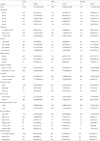2. Kogi K, Thurman JE. Trends in approaches to night and shiftwork and new international standards. Ergonomics. 1993; 36:3–13. DOI:
10.1080/00140139308967849. PMID:
8440226.
3. Parent-Thirion A, Vermeylen G, Van Houten G, Lyly-Yrjänäinen M, Biletta I, Cabrita J, et al. Fifth European working conditions survey. 2012. Luxembourg: Eurofound, Publications Office of the European Union.
4. Caruso C, Rosa RR. Rom WN, editor. Shift work and long work hours. Environmental and Occupational Medicine. 2007. 4. Philadelphia: Lippincott Williams & Wilkins;p. 1359–72.
5. Park TJ, Pack DM, Joh KO, Park JS, Cho SI. The relationship between shift work and work-related injuries among Korean workers. Korean J Occup Environ Med. 2012; 24:52–60.
6. Wang JH, Lee G, Song JT, Kwon J, Choi H, Lim S, et al. The association between shift work and bone mineral density : analysis of 2008–2009 Korean National Health and Nutrition Examination Survey. Korean J Occup Environ Med. 2012; 24:274–86.
7. Sallinen M, Kecklund G. Shift work, sleep, and sleepiness-differences between shift schedules and systems. Scand J Work Environ Health. 2010; 36:121–33. DOI:
10.5271/sjweh.2900. PMID:
20119631.
8. Wagstaff AS, Sigstad Lie JA. Shift and night work and long working hours-a systematic review of safety implications. Scand J Work Environ Health. 2011; 37:173–85. DOI:
10.5271/sjweh.3146. PMID:
21290083.
9. Driesen K, Jansen NW, Kant I, Mohren DC, van Amelsvoort LG. Depressed mood in the working population: associations with work schedules and working hours. Chronobiol Int. 2010; 27:1062–79. DOI:
10.3109/07420528.2010.489877. PMID:
20636216.
10. Härmä M. Workhours in relation to work stress, recovery and health. Scand J Work Environ Health. 2006; 32:502–14. DOI:
10.5271/sjweh.1055. PMID:
17173206.
11. Lowden A, Moreno C, Holmbäck U, Lennernäs M, Tucker P. Eating and shift work-effects on habits, metabolism, and performance. Scand J Work Environ Health. 2010; 36:150–62. DOI:
10.5271/sjweh.2898. PMID:
20143038.
12. Tenkanen L, Sjöblom T, Härmä M. Joint effect of shift work and adverse life-style factors on the risk of coronary heart disease. Scand J Work Environ Health. 1998; 24:351–7. DOI:
10.5271/sjweh.355. PMID:
9869306.
13. Frost P, Kolstad HA, Bonde JP. Shift work and the risk of ischemic heart disease-a systematic review of the epidemiologic evidence. Scand J Work Environ Health. 2009; 35:163–79. DOI:
10.5271/sjweh.1319. PMID:
19387517.
14. Knutsson A, Bøggild H. Gastrointestinal disorders among shift workers. Scand J Work Environ Health. 2010; 36:85–95. DOI:
10.5271/sjweh.2897. PMID:
20101379.
15. Kolstad HA. Nightshift work and risk of breast cancer and other cancers-a critical review of the epidemiological evidence. Scand J Work Environ Health. 2008; 34:5–22. DOI:
10.5271/sjweh.1194. PMID:
18427694.
19. Mikkelsen KL, Heimann BL, Keiding N, Sorensen TI. Independent effects of stable and changing body weight on total mortality. Epidemiology. 1999; 10:671–8. DOI:
10.1097/00001648-199911000-00005. PMID:
10535779.
20. Willett WC, Manson JE, Stampfer MJ, Colditz GA, Rosner B, Speizer FE, et al. Weight, weight change, and coronary heart disease in women: risk within the ‘normal’ weight range. JAMA. 1995; 273:461–5. DOI:
10.1001/jama.1995.03520300035033. PMID:
7654270.
21. Ford ES, Williamson DF, Liu S. Weight change and diabetes incidence: findings from a national cohort of US adults. Am J Epidemiol. 1997; 146:214–22. DOI:
10.1093/oxfordjournals.aje.a009256. PMID:
9247005.
22. Huang Z, Hankinson SE, Colditz GA, Stampfer MJ, Hunter DJ, Manson JE, et al. Dual effects of weight and weight gain on breast cancer risk. JAMA. 1997; 278:1407–11. DOI:
10.1001/jama.1997.03550170037029. PMID:
9355998.
23. Ensrud KE, Ewing SK, Stone KL, Cauley JA, Bowman PJ, Cummings SR. Intentional and unintentional weight loss increase bone loss and hip fracture risk in older women. J Am Geriatr Soc. 2003; 51:1740–7. DOI:
10.1046/j.1532-5415.2003.51558.x. PMID:
14687352.
24. Sahyoun N, Serdula M, Galuska D, Zhang X, Pamuk E. The epidemiology of recent involuntary weight loss in the United States population. J Nutr Health Aging. 2003; 8:510–7. PMID:
15543425.
25. Kivimäki M, Head J, Ferrie J, Shipley M, Brunner E, Vahtera J, et al. Work stress, weight gain and weight loss: evidence for bidirectional effects of job strain on body mass index in the Whitehall II study. Int J Obes (Lond). 2006; 30:982–7. DOI:
10.1038/sj.ijo.0803229. PMID:
16418750.
26. Quist HG, Christensen U, Christensen KB, Aust B, Borg V, Bjorner JB. Psychosocial work environment factors and weight change: a prospective study among Danish health care workers. BMC Public Health. 2013; 13:43. DOI:
10.1186/1471-2458-13-43. PMID:
23327287.
27. Esquirol Y, Perret B, Ruidavets JB, Marquie JC, Dienne E, Niezborala M, et al. Shift work and cardiovascular risk factors: new knowledge from the past decade. Arch Cardiovasc Dis. 2011; 104:636–68. DOI:
10.1016/j.acvd.2011.09.004. PMID:
22152516.
28. van Amelsvoort LG, Schouten EG, Kok FJ. Impact of one year of shift work on cardiovascular disease risk factors. J Occup Environ Med. 2004; 46:699–706. DOI:
10.1097/01.jom.0000131794.83723.45. PMID:
15247809.
29. Lee S, McCann D, Messenger JC. Working time around the world. 2007. Geneva: ILO.
32. Kroke A, Liese AD, Schulz M, Bergmann MM, Klipstein-Grobusch K, Hoffmann K, et al. Recent weight changes and weight cycling as predictors of subsequent two year weight change in a middle-aged cohort. Int J Obes Relat Metab Disord. 2002; 26:403–9. DOI:
10.1038/sj.ijo.0801920. PMID:
11896497.
33. Antunes L, Levandovski R, Dantas G, Caumo W, Hidalgo M. Obesity and shift work: chronobiological aspects. Nutr Res Rev. 2010; 23:155–68. DOI:
10.1017/S0954422410000016. PMID:
20122305.
34. van Drongelen A, Boot CR, Merkus SL, Smid T, van der Beek AJ. The effects of shift work on body weight change-a systematic review of longitudinal studies. Scand J Work Environ Health. 2011; 37:263–75. DOI:
10.5271/sjweh.3143. PMID:
21243319.
35. Suwazono Y, Dochi M, Sakata K, Okubo Y, Oishi M, Tanaka K, et al. A longitudinal study on the effect of shift work on weight gain in male Japanese workers. Obesity (Silver Spring). 2008; 16:1887–93. DOI:
10.1038/oby.2008.298. PMID:
18535539.
36. Hannerz H, Albertsen K, Nielsen ML, Tüchsen F, Burr H. Occupational factors and 5-year weight change among men in a danish national cohort. Health Psychol. 2004; 23:283–8. DOI:
10.1037/0278-6133.23.3.283. PMID:
15099169.
37. Roos E, Lallukka T, Rahkonen O, Lahelma E, Laaksonen M. Working conditions and major weight gain-a prospective cohort study. Arch Environ Occup Health. 2013; 68:166–72. DOI:
10.1080/19338244.2012.686931. PMID:
23566324.
38. Liu Y, Tanaka H; Fukuoka Heart Study Group. Overtime work, insufficient sleep, and risk of non-fatal acute myocardial infarction in Japanese men. Occup Environ Med. 2002; 59:447–51. DOI:
10.1136/oem.59.7.447. PMID:
12107292.
39. Bøggild H, Burr H, Tüchsen F, Jeppesen HJ. Work environment of Danish shift and day workers. Scand J Work Environ Health. 2001; 27:97–105. DOI:
10.5271/sjweh.595. PMID:
11409602.
40. Tenkanen L, Sjöblom T, Kalimo R, Alikoski T, Härmä M. Shift work, occupation and coronary heart disease over 6 years of follow-up in the Helsinki Heart Study. Scand J Work Environ Health. 1997; 23:257–65. DOI:
10.5271/sjweh.218. PMID:
9322816.
41. Kim HI, Jung S, Choi JY, Kim S-E, Jung H-K, Shim K-N, et al. Impact of shiftwork on irritable bowel syndrome and functional dyspepsia. J Korean Med Sci. 2013; 28:431–7. DOI:
10.3346/jkms.2013.28.3.431. PMID:
23487413.
42. Cho HS, Kim YW, Park HW, Lee KH, Jeong BG, Kang YS, et al. The relationship between depressive symptoms among female workers and job stress and sleep quality. Ann Occup Environ Med. 2013; 25:12. DOI:
10.1186/2052-4374-25-12. PMID:
24472381.
43. Song JT, Lee G, Kwon J, Park JW, Choi H, Lim S. The association between long working hours and self-rated health. Ann Occup Environ Med. 2014; 26:2. DOI:
10.1186/2052-4374-26-2. PMID:
24472333.
44. Park SG, Min KB, Chang SJ, Kim HC, Min JY. Job stress and depressive symptoms among Korean employees: the effects of culture on work. Int Arch Occup Environ Health. 2009; 82:397–405. DOI:
10.1007/s00420-008-0347-8. PMID:
18622624.









 PDF
PDF Citation
Citation Print
Print


 XML Download
XML Download